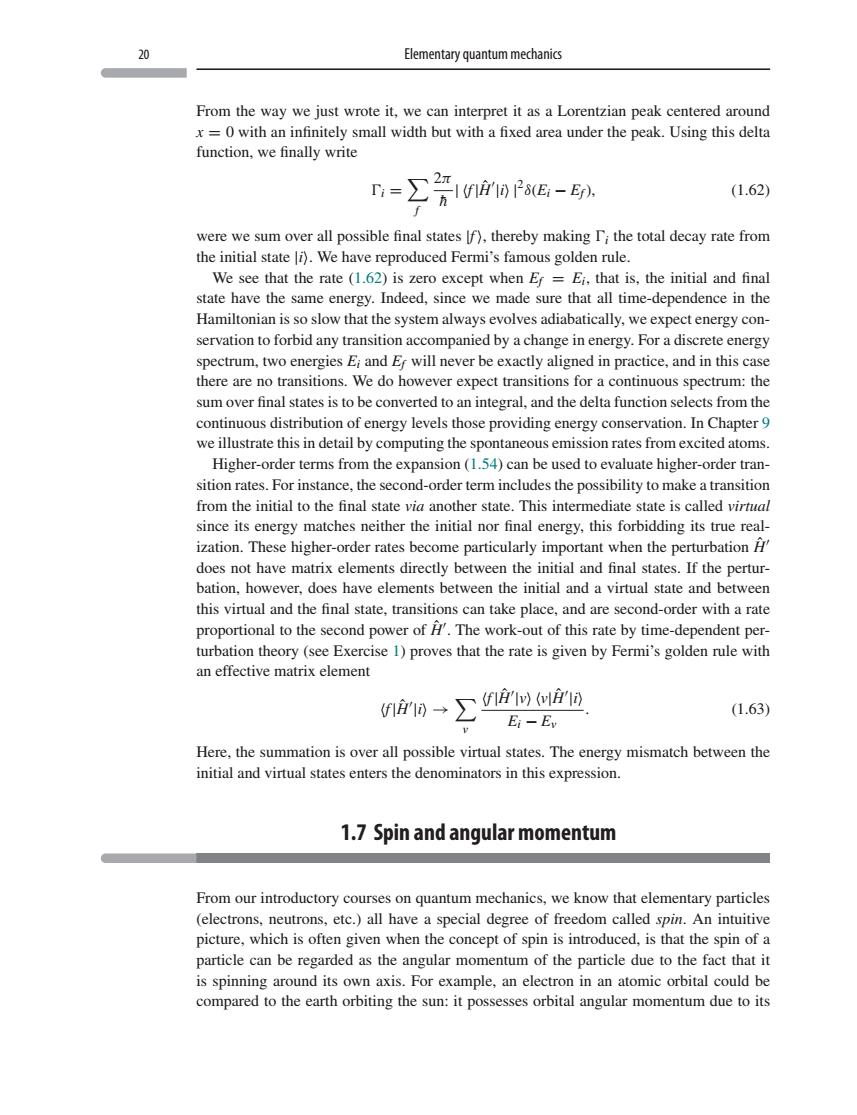正在加载图片...

Elementary quantum mechanics From the way we just wrote it,we can interpret it as a Lorentzian peak centered around x=0with an infinitely small width but with a fixed area under the peak.Using this delta function.we finally writ 2π D=】 (1.62 were we sum over all possible final states f).thereby making Ithe total decay rate from the have reproduced Fermi's far ous golden We see that the rate (1.62)is zero except when Er =Ei.that is,the initial and final state have the same energy.Indeed.since we made sure that all time-dependence in the Hamiltonian is so slow that the system always evolves adiabatically,we expect energy con- servation to forbid any transition accompanied by a change in energy.For adiscrete energ spectrum,two ene E:and E ill never be in practice.and n ths ons.We do however expect transitions for a continuous spectrum:th sum over final states is to be converted to an integral,and the delta function selects from the continuous distribution of energy levels those providing energy conservation.In Chapter9 we illustrate this in detail by computing the spontaneous emission rates from excited atoms Higher-order terms from the expansion(1.54)can be used to evaluate higher-order tran sition rates.For ins ance,the second-orde rterm include es the possibility to make atr from the initial to the final state via another state.This intermediate state is called virtud since its energy matches neither the initial nor final energy.this forbidding its true real ization.These higher-order rates become particularly important when the perturbation A does not have matrix elements directly between the initial and final states.If the pertur bation.howeve does have elements between the initial and a virtual state and be this virtual and the final state,transi ons can take place.and are second-order with a rate proportional to the second power of H.The work-out of this rate by time-dependent per turbation theory (see Exercise 1)proves that the rate is given by Fermi's golden rule with an effective matrix element A)→∑创府n Ei-Ev (1.63) Here,the summation is over all possible virtual states.The energy mismatch between the initial and virtual states enters the denominators in this expression. 1.7 Spin and angular momentum From our introductory courses on quantum mechanics,we know that elementary particles (electrons,neutrons.etc.)all have a special degree of freedom called spin.An intuitive picture,which is often given when the ncept of spin is introduced,is that the spin of particle can be regarded as the angular momentum of the particle due to the fact that i is spinning around its own axis.For example,an electron in an atomic orbital could be compared to the earth orbiting the sun:it possesses orbital angular momentum due to its20 Elementary quantum mechanics From the way we just wrote it, we can interpret it as a Lorentzian peak centered around x = 0 with an infinitely small width but with a fixed area under the peak. Using this delta function, we finally write i = f 2π h¯ | f |Hˆ |i |2δ(Ei − Ef), (1.62) were we sum over all possible final states |f, thereby making i the total decay rate from the initial state |i. We have reproduced Fermi’s famous golden rule. We see that the rate (1.62) is zero except when Ef = Ei, that is, the initial and final state have the same energy. Indeed, since we made sure that all time-dependence in the Hamiltonian is so slow that the system always evolves adiabatically, we expect energy conservation to forbid any transition accompanied by a change in energy. For a discrete energy spectrum, two energies Ei and Ef will never be exactly aligned in practice, and in this case there are no transitions. We do however expect transitions for a continuous spectrum: the sum over final states is to be converted to an integral, and the delta function selects from the continuous distribution of energy levels those providing energy conservation. In Chapter 9 we illustrate this in detail by computing the spontaneous emission rates from excited atoms. Higher-order terms from the expansion (1.54) can be used to evaluate higher-order transition rates. For instance, the second-order term includes the possibility to make a transition from the initial to the final state via another state. This intermediate state is called virtual since its energy matches neither the initial nor final energy, this forbidding its true realization. These higher-order rates become particularly important when the perturbation Hˆ does not have matrix elements directly between the initial and final states. If the perturbation, however, does have elements between the initial and a virtual state and between this virtual and the final state, transitions can take place, and are second-order with a rate proportional to the second power of Hˆ . The work-out of this rate by time-dependent perturbation theory (see Exercise 1) proves that the rate is given by Fermi’s golden rule with an effective matrix element f |Hˆ |i → v f |Hˆ |v v|Hˆ |i Ei − Ev . (1.63) Here, the summation is over all possible virtual states. The energy mismatch between the initial and virtual states enters the denominators in this expression. 1.7 Spin and angular momentum From our introductory courses on quantum mechanics, we know that elementary particles (electrons, neutrons, etc.) all have a special degree of freedom called spin. An intuitive picture, which is often given when the concept of spin is introduced, is that the spin of a particle can be regarded as the angular momentum of the particle due to the fact that it is spinning around its own axis. For example, an electron in an atomic orbital could be compared to the earth orbiting the sun: it possesses orbital angular momentum due to its